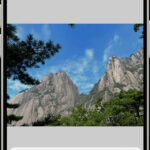iPhones are incredibly powerful cameras that you carry in your pocket every day. To really make your photos stand out, it’s about understanding a few key techniques that go beyond just pointing and shooting. With a little know-how, you can transform your everyday snapshots into impressive images.
Mastering the basics of your iPhone camera is the first step. Explore the different camera modes like Photo, Portrait, and Cinematic to understand when to use each one for the best effect. Learn to control focus and exposure by simply tapping on your screen – tapping to focus on your subject also adjusts the light. For tricky lighting situations, use AE/AF Lock by holding your finger on the screen; this locks in your desired focus and brightness. Don’t forget the grid feature in your settings; it’s a fantastic tool to help you compose balanced and visually appealing shots by using the rule of thirds.
Composition is where you can really elevate your iPhone photography. The rule of thirds suggests positioning your subject at the intersection of the grid lines for a more dynamic image. Look for leading lines in your environment – roads, fences, or paths – to draw the viewer’s eye into your photo. Symmetry and patterns are also visually striking; find them in architecture or nature and use them to create captivating and balanced compositions.
Lighting is arguably the most crucial element in photography, even with an iPhone. Natural light is your best friend; it’s soft, flattering, and brings out the best in your subjects. The golden hour, the hour after sunrise and before sunset, provides warm, magical light that can make any photo look incredible. Conversely, avoid harsh direct sunlight at midday as it can create strong shadows and washed-out colors.
Taking great photos with your iPhone is a skill that improves with practice. Experiment with these techniques, explore different perspectives, and most importantly, keep shooting. The more you practice, the better you’ll become at seeing and capturing the world around you through your iPhone lens.
